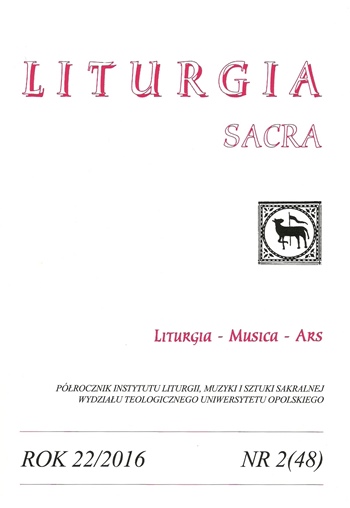Il simbolo sponsale come ponte tra le tradizioni greca e siriaca: Un approccio patristico-liturgico
The spousal symbolism as a bridge between the Greek and Syriac traditions: an approach patristic and liturgical
Part two
Author(s): Bishara EbeidSubject(s): Christian Theology and Religion, Theology and Religion
Published by: Uniwersytet Opolski
Keywords: sposo; sposa; Cristo; incarnazione; battesimo; Cantico; nuziale; sponsale; unione;
Summary/Abstract: The relationship between God and human being was seen, already in the Old Testament, as amorous. The image that was most preferred, with which this relationship could be described, was the spousal image. It was used metaphorically to underline, on the one hand, the desire of the man-bride to go back to paradise, after his fall, and to be with his Godbridegroom and to join Him, and on the other, the will of God-bridegroom himself, being in his garden-paradise, to invite His bride to come and to enter to make the nuptial feast with Him. The Canticle of Canticles (the Song of Songs), in fact, is to be considered the most excellent hymn that describes and reflects on this relationship. Adam with his sin could not realize the purpose for which he was created, i.e. his deification. It was, however, God’s plan for the human nature, and for that the Logos himself chose to become man and to make real the purpose of his creation of Adam, and for this reason He was also called the new Adam. This dogma of faith became the basis of the Church’s adoption the spousal image, according to which Christ is the bridegroom while the Christians, as members of His Church, His body, are the bride. The new relationship in Christ begins with the Baptism, while through the Eucharist the first step in joining Him is made. This symbolic image, nevertheless, has an eschatological aspect that gives a strong dynamism for the Christian in his liturgical and spiritual life. At the eschaton the garden-paradise, the heavenly Jerusalem, will descend on the earth, in its center will be the bridegroom and he will call his bride inviting her to enter; and during their nuptial feast he will sing the Canticle, the nuptial hymn. With our article, therefore, we attempted to illustrate this symbolic image, starting from its dogmatic base, then presenting its biblical background, analyzing the patristic interpretations and making a few references to the liturgical life and its hymns that confirm the new relationship in Christ. Comparing, finally, throughout this analysis, on one hand, the Greek patristic tradition and the Byzantine liturgical hymns, on the other, the Syriac patristic and liturgical tradition, we tried to show how this image might be a real ecumenical bridge, as a common element among these two traditions.
Journal: Liturgia Sacra
- Issue Year: XXII/2016
- Issue No: 48
- Page Range: 431-454
- Page Count: 24
- Language: Italian
- Content File-PDF

